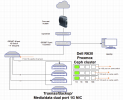root@mystic1:~# ./cephadm install
Installing packages ['cephadm']...
Non-zero exit code 100 from apt-get install -y cephadm
apt-get: stdout Reading package lists...
apt-get: stdout Building dependency tree...
apt-get: stdout Reading state information...
apt-get: stdout cephadm is already the newest version (17.2.6-pve1+3).
apt-get: stdout The following packages were automatically installed and are no longer required:
apt-get: stdout g++-10 libfmt7 libstdc++-10-dev libthrift-0.13.0 libtiff5 libwebp6
apt-get: stdout pve-kernel-5.15.107-1-pve pve-kernel-5.15.107-2-pve python-pastedeploy-tpl
apt-get: stdout telnet
apt-get: stdout Use 'apt autoremove' to remove them.
apt-get: stdout 0 upgraded, 0 newly installed, 0 to remove and 0 not upgraded.
apt-get: stdout 1 not fully installed or removed.
apt-get: stdout After this operation, 0 B of additional disk space will be used.
apt-get: stdout Setting up cephadm (17.2.6-pve1+3) ...
apt-get: stdout usermod: unlocking the user's password would result in a passwordless account.
apt-get: stdout You should set a password with usermod -p to unlock this user's password.
apt-get: stdout mkdir: cannot create directory ‘/home/cephadm/.ssh’: No such file or directory
apt-get: stdout dpkg: error processing package cephadm (--configure):
apt-get: stdout installed cephadm package post-installation script subprocess returned error exit status 1
apt-get: stdout Errors were encountered while processing:
apt-get: stdout cephadm
apt-get: stderr E: Sub-process /usr/bin/dpkg returned an error code (1)
Traceback (most recent call last):
File "/root/./cephadm", line 9653, in <module>
main()
File "/root/./cephadm", line 9641, in main
r = ctx.func(ctx)
^^^^^^^^^^^^^
File "/root/./cephadm", line 8123, in command_install
pkg.install(ctx.packages)
File "/root/./cephadm", line 7751, in install
call_throws(self.ctx, ['apt-get', 'install', '-y'] + ls)
File "/root/./cephadm", line 1852, in call_throws
raise RuntimeError(f'Failed command: {" ".join(command)}: {s}')
RuntimeError: Failed command: apt-get install -y cephadm: E: Sub-process /usr/bin/dpkg returned an error code (1)



